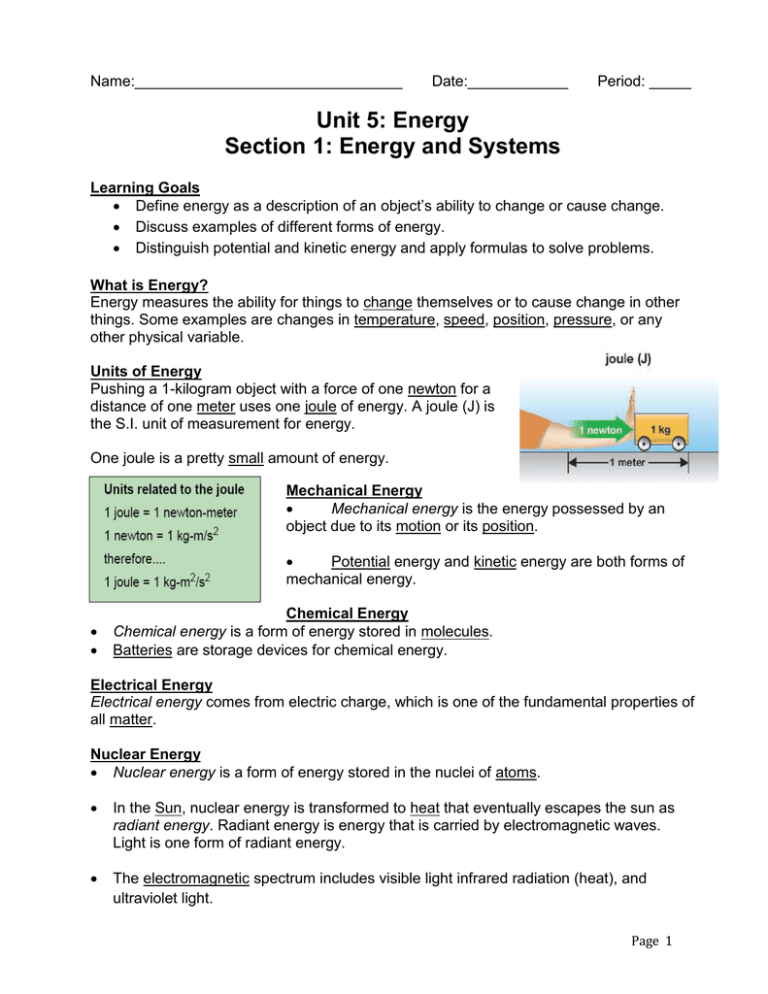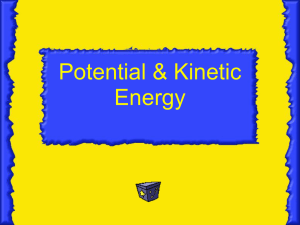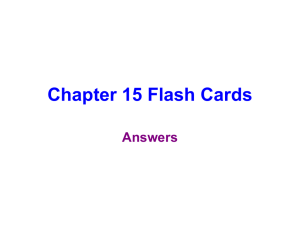Unit 5 Section 1 Notes and Worksheets Answer Key - WAHS
advertisement

Name:________________________________ Date:____________ Period: _____ Unit 5: Energy Section 1: Energy and Systems Learning Goals Define energy as a description of an object’s ability to change or cause change. Discuss examples of different forms of energy. Distinguish potential and kinetic energy and apply formulas to solve problems. What is Energy? Energy measures the ability for things to change themselves or to cause change in other things. Some examples are changes in temperature, speed, position, pressure, or any other physical variable. Units of Energy Pushing a 1-kilogram object with a force of one newton for a distance of one meter uses one joule of energy. A joule (J) is the S.I. unit of measurement for energy. One joule is a pretty small amount of energy. Mechanical Energy Mechanical energy is the energy possessed by an object due to its motion or its position. Potential energy and kinetic energy are both forms of mechanical energy. Chemical Energy Chemical energy is a form of energy stored in molecules. Batteries are storage devices for chemical energy. Electrical Energy Electrical energy comes from electric charge, which is one of the fundamental properties of all matter. Nuclear Energy Nuclear energy is a form of energy stored in the nuclei of atoms. In the Sun, nuclear energy is transformed to heat that eventually escapes the sun as radiant energy. Radiant energy is energy that is carried by electromagnetic waves. Light is one form of radiant energy. The electromagnetic spectrum includes visible light infrared radiation (heat), and ultraviolet light. Page 1 Light energy and heat energy are included in the electromagnetic spectrum. Sources of Energy Without the Sun’s energy, Earth would be a cold icy place with a temperature of -273 C. As well as warming the planet, the Sun’s energy drives the entire food chain. All objects with mass feel forces in the presence of Earth’s gravity. These forces are a source of energy for objects or moving matter such as falling rocks and falling water. Energy and Work In physics, the word work has a very specific meaning. Work is the transfer of energy that results from applying a force over a distance. Page 2 Potential Energy Systems or objects with potential energy are able to exert forces (exchange energy) as they change. Potential energy is energy due to position. Label the parts of the equation below. Strength of gravity (9.8 N/kg) Potential Energy (joules) EP = mgh Height of object (meters) Mass of object (kilograms) Kinetic Energy Energy of motion is called kinetic energy. A moving cart has kinetic energy because it can hit another object (like clay) and cause change. Label the parts of the equation below. Mass of object (kilograms) Kinetic Energy (joules) EK = ½ mv2 Velocity of object (meters/second) Sample Problem A 2 kg rock is at the edge of a cliff 20 meters above a lake. It becomes loose and falls toward the water below. Calculate its potential and kinetic energy when it is at the top and when it is halfway down. Its speed is 14 m/s at the halfway point. 1. Looking for: initial EK, EP and EK, EP half way down. 2. Given: mass = 2.0 kg; h = 20 m, v = 14 m/s (half way) 3. Relationships: EP =mgh EK = ½ mv2 Assume rock starts from rest. Initial EK and EP Halfway EK and EP Page 3 Vocabulary energy – a quantity that describes the ability of an object to change or cause changes. joule (J) – a unit of energy. One joule is enough energy to push with a force of 1 newton for a distance of 1 meter. mechanical energy – a form of energy that is related to motion or position. Potential and kinetic energy are examples. chemical energy – a form of potential energy that is stored in molecules. nuclear energy – a form of energy that is stored in the nuclei of atoms. radiant energy – a form of energy that is represented by the electromagnetic spectrum. potential energy – energy due to position. kinetic energy – energy of motion. Review Questions 1. The quantity that is related to the ability of an object to change or cause change. ______________________ 2. Name four changes that can occur in response to a change in energy. ______________________ ______________________ 3. What is the correct unit for a joule? a. 1 kg-m/s b. 1 kg-m2/s2 _____________________ _____________________ c. 1 g-cm/s d. 1 kg-cm2/s2 4. Mechanical energy includes __________________ and ___________________ energies. 5. The flow of energy from the __________ supports all life on Earth. 6. What does “doing work” mean when it comes to physics? ____________________________________________________ ____________________________________________________ Page 4 7. Potential energy depends on ____________, ______________, and ______________. 8. Write the equation for calculating potential energy. _____________________ 9. Write the equation for calculating kinetic energy. _____________________ 10. Kinetic energy depends on _______________ and ________________. Page 5 James Prescott Joule The young student James Joule was born near Manchester, England on December 24, 1818. His father was a wealthy brewery owner. James injured his spine when he was young and as a result he spent a great deal of time indoors, reading and studying. When he became interested in science, his father built him a lab in the basement. When James was fifteen years old, his father hired John Dalton, a leading scientist at the time, to tutor James and his brother. Dalton believed that a scientist needed a strong math background. He spent four years teaching the boys Euclidian mathematics. He also taught them the importance of taking exact measurements, a skill that strongly influenced James in his scientific endeavors. Brewer first, scientist second After their father became ill, James and his brother, Benjamin, ran the family brewery. James loved the brewery, but he also loved science. He continued to perform experiments as a serious hobby. In his lab, he tried to make a better electric motor using electromagnets. James wanted to replace the old steam engines in the brewery with these new motors. Though he learned a lot about magnets, heat, motion, and work, he was not able to change the steam engines in the brewery. The cost of the zinc needed to make the batteries for the electric motors was much too high. Steam engines fired by coal were more cost efficient. The young scientist In 1840, when he was only twenty-two years old, Joule wrote what would later be known as Joule’s Law. This law explained that electricity produces heat when it travels through a wire due to the resistance of the wire. Joule’s Law is still used today to calculate the amount of heat produced from electricity. By 1841, Joule focused most of his attention on the concept of heat. He disagreed with most of his peers who believed that heat was a fluid called caloric. Joule argued that heat was a state of vibration caused by the collision of molecules. He showed that no matter what kind of mechanical work was done, a given amount of mechanical work always produced the same amount of heat. Thus, he concluded, heat was a form of energy. He established this kinetic theory nearly 100 years before others truly accepted that molecules and atoms existed. On his honeymoon In 1847, Joule married Amelia Grimes, and the couple spent their honeymoon in the Alps. Joule had always been fascinated by waterfalls. He had observed that water was warmer at the bottom of a waterfall than at the top. He believed that the energy of the falling water was transformed into heat energy. While he and his new bride were in the Alps, he tried to prove his theory. His experiment failed because there was too much spray from the waterfall, and the water did not fall the correct distance for his calculations to work. From 1847–1854, Joule worked with a scientist named William Thomson. Together they studied thermodynamics and the expansion of gases. They learned how gases react under different conditions. Their law, named the Joule-Thomson effect, explains that compressed gases cool when they are allowed to expand under the right conditions. Their work later led to the invention of refrigeration. James Joule died on October 11, 1889. The international unit of energy is called the Joule in his honor. Page 6 Name:________________________________ Date:____________ Period: _____ Unit 5: Energy, Section 1: Energy and Systems Guided Problem Practice Potential energy The word potential means that something is capable of becoming active. Potential energy sometimes is referred to as stored energy. This type of energy often comes from the position of an object relative to Earth. A diver on the high diving board has more energy than someone who dives into the pool from the low dive. The formula to calculate the potential energy of an object is the mass of the object times the acceleration due to gravity (9.8 m/s2) times the height of the object. Ep = mgh mass of the object (kilograms) x 9.8 m/s2 = weight of the object (newtons) Did you notice that the mass of the object in kilograms times the acceleration of gravity (g) is the same as the weight of the object in newtons? Therefore you can think of an object’s potential energy as equal to the object’s weight multiplied by its height. So... EP = weight of object × height of object _______________________________________________________________ Sample 1: Potential Energy Problem What is the potential energy of a 10 N book that is placed on a shelf that is 2.5 meters high? Looking for The potential energy of the book in joules. Given Weight of book = 10 N Height of shelf = 2.5 m Solution The book’s weight (10 N) is equal to its mass times the acceleration of gravity. Therefore, you can easily use this value in the potential energy formula: Relationship 3 EP = mgh potential energy = mgh =(10 N)(2.5 m)= 25 N·m = 25 joules ________________________________________________________________ Kinetic energy Kinetic energy is the energy of motion. Kinetic energy depends on the mass of the object as well as the speed of that object. Just think of a large object moving at a very high speed. You would say that the object has a lot of energy. Since the object is moving, it has kinetic energy. The formula for kinetic energy is: EK = ½ mv2 Page 7 Sample 2: Kinetic Energy Problem A 50 kg boy and his 100 kg father went jogging. Both ran at a rate of 5 m/s. Who had more kinetic energy? Show your work and explain. Looking for The kinetic energy of the father and his son in joules. Given Boy = 50 kg, father = 100 kg Speed = 5 m/s Relationship EK = ½ mv2 Solution Energy of boy: ½ (50 kg) (5 m/s)2 = 625 m2/s2 = 625 joules Energy of father: ½ (100 kg) (5 m/s)2 = 1,250 m2/s2 = 1,250 joules The father has the greater kinetic energy. Practice Problems 1. Determine the amount of potential energy of a 5.0-N book that is moved to three different shelves on a bookcase. The height of each shelf is 1.0 m, 1.5 m, and 2.0 m. EP at 1.0 m = ___________ EP at 1.5 m = ____________ EP at 2.0 m = ____________ 2. What is the potential energy of a 1,800 kg car about to roll over a cliff with the height of 150 meters? ________________________ 3. What is the kinetic energy of a 2,000 kg boat moving at 5.0 m/s? ________________________ 4. What is the kinetic energy of a 125 kg girl running at a rate of 3.0 m/s? _____________________ Page 8 Name:________________________________ Date:____________ Period: _____ Unit 5: Energy, Section 1: Energy and Systems Potential and Kinetic Energy Problem Practice Potential energy The formula to calculate the potential energy of an object is the mass of the object times the acceleration due to gravity (9.8 m/s2) times the height of the object. Ep = (mass)(gravity)(height) mass = kilograms gravity = 9.8 N/kg EP = (weight)(height) height = meters weight = newtons Kinetic energy Kinetic energy depends on the mass of the object as well as the speed of that object. The formula for kinetic energy is the velocity squared, times the mass, times ½. EK = ½ mv2 mass = kilograms velocity = meters/second Energy = joules Steps to solving a problem: 1. Determine whether you are looking for potential or kinetic energy. 2. Choose which equation to use. 3. “Plug in” the values you know. Pay attention to units, they can help you determine which variables were given to you. _______________________________________________________________________________ Problems: 1. Your friend places a glass vase on the edge of a table that is 1.5 meters high. The vase has a mass or 0.25 kg. What is its potential energy? ___________________ 2. A 1.0 kg ball is thrown into the air with an initial velocity of 30 m/s. How much kinetic energy does the ball have? _____________________ 3. A pen has a weight of 1.8 newtons and it is about to tumble out of pocket on a pair of jeans which is 0.8 meters above the ground. What is its potential energy? __________________ Page 9 4. A bus full of tourists starts rolling towards a cliff, everyone gets off in time, but the bus continues to roll towards its doom! The bus has a mass of 9,000 kg and the height of the cliff is 250 meters. a. What is the potential energy at the top of the cliff? _____________________ b. What is kinetic energy at the top of the cliff? _____________________ c. What is the potential energy halfway down into its fall? _____________________ d. What is the kinetic energy halfway down into its fall? ___________________ Hint: You don’t need to know the velocity! 5. What is the kinetic energy of a 500 kg elevator traveling at a speed of 4 m/s? ____________ 6. What is the kinetic energy of an object traveling at 30 m/s and with a mass of 18.75 kg? __________________ 7. A coin with a mass of 0.02 kg is dropped towards a fountain 3 meters below. After falling for 2 meters, its velocity is 19.6 m/s. a. What is the coin’s kinetic energy at this point in its fall? __________________ b. What is the coin’s potential energy at this point in its fall? __________________ 8. What is the potential energy of a 15 newton object raised by 3.5 meters? ________________ Challenge question: 9. Find the velocity of an object that has a mass of 5 kg and a kinetic energy of 22.5 joules. Page 10



